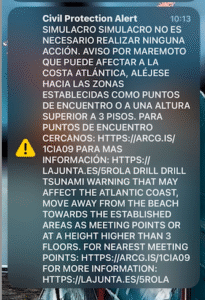Image may exaggerate what really happened. Photo credit: Molly Grace’s wild imagination
Cádiz staged Spain’s largest-ever tsunami drill on November 20, sending a mass emergency alert to thousands of mobile phones along Spain’s Atlantic ‘Costa de la Luz’. As part of Respuesta 25, the regional government simulated a 7.6-magnitude earthquake similar to the 1755 Lisbon event. More than 20,000 people across schools, hotels, historic buildings, town centres and coastal areas participated in evacuation exercises, some calmly, some with confusion, and a few with slightly more…Panic.
The drill formed part of a broader initiative by the Junta de Andalucía to modernise its emergency response system and test the recently implemented ES-Alert, often referred to as the “Reverse 112” system. Unlike traditional emergency calls, ES-Alert sends geo-targeted messages directly to phones in an affected region, overriding silent mode and triggering a loud alarm impossible to ignore—much to the horror of anyone in the immediate vicinity of easily-startled mammals. The simulation involved coordination between firefighters, local police, Civil Protection, the military’s UME unit, and municipal workers across Cádiz province. Several coastal towns ran full evacuation rehearsals, moving people to safe assembly points or directing them up to higher floors of public buildings.
Meanwhile, my own experience of this highly organised drill was… slightly less organised.
A Normal Morning… Until It Wasn’t
The morning of November 20 found me deep inside the Andalucian Show Jumping Championship at Montenmedio in Vejer de la Frontera (Cadiz). I’d started at 07:30, tending to horses and riders, blissfully unaware that I was standing in one of the worst possible places to experience every phone in the area shrieking at once, a field full of highly strung, flight-prone animals.
If ever there were a day I should have remembered something important, this was it. But, as expected, I did not.
At exactly 10:13, despite being scheduled for 10:00, because even tsunami drills, it seems, prefer to show up late in Andalucía, the alarms finally blasted across the arena.
A chorus of horses breaking wind erupted like a brass section warming up. Dozens of animals launched into the air like startled kites. Legs shot in every direction. Riders clung on as if auditioning for John Wayne: The Return. The shrill alarm echoed off the warm-up arenas like we were under alien attack.
And then I remembered:
Ah yes… The tsunami drill.
The timing of the alarm was specifically chosen to mimic a realistic emergency scenario. Officials estimated that in a real Lisbon-style earthquake, Cádiz residents would have approximately 10 to 15 minutes before a tsunami could reach the coastline. The drill was therefore designed to simulate this narrow window, testing not only technological systems but also public reaction, an area where the horse world that morning provided its own very lively data set.
Chaos, Confusion, and Riders in Flight
As the alarms went off on everyones phones, several people around me grew visibly nervous. Children shouted “TSUNAMIIII!?” and sprinted toward their parents.
I grabbed the loudspeaker and announced, “THE TSUNAMI WARNING IS A DRILL!”
One rider, wrestling her airborne horse, screamed, “Tell that to my horse!!” as she shot past me in full rodeo mode.
Gradually, calm returned. The horses resumed bouncing over jumps as if nothing had happened. Riders regained their dignity. The children stopped shouting about imminent watery doom.
But elsewhere across Cádiz, things were a bit more structured.
Beyond Montenmedio, authorities carried out controlled evacuations in schools, where children were guided through pre-planned escape routes, and in hospitals and care homes, where staff practised “vertical evacuation”—moving patients to upper floors rather than attempting to transport them outside. Historic sites such as the Museo de Cádiz even practised protecting collections, rehearsing how artefacts would be secured or relocated in a real emergency. Restaurants, shops, and beachfront bars briefly paused service as staff participated in the protocol.
What the Rest of Cádiz Did
For many people, hotel guests, schoolchildren, diners, tourists, the drill required actual protocol:
- Move to designated tsunami meeting points
- Follow evacuation routes
- Or, if none were nearby, climb to a structure at least three floors high
Everyone received a link with the alert to check their nearest safe point. Naturally, I clicked it.
I expected a map. A diagram. Maybe a government page.
What I got was:
Pollo AI.
Yes. Chicken AI.
A website for generating AI chicken videos??
I truly hope that in a real emergency, the public is not directed to a poultry-themed algorithm as their lifeline.
Thankfully, a second link worked perfectly and redirected me to the official Junta de Andalucía page titled “What to Do in Case of a Tsunami.”
Useful. Slightly less feathered.
In fairness to the system, the inclusion of links was actually part of the test: officials wanted to ensure residents could access proper guidance during a high-pressure situation. However, given the sheer number of people receiving the alert simultaneously, it wouldn’t be surprising if certain URLs became briefly overloaded, something emergency planners are likely to note in their post-drill evaluation.
The Shock Factor
The alarm took many by surprise. Visitors from outside Andalucía, some from outside Spain altogether, had no idea a drill was planned.
One woman told me:
“If it had been a real situation, it would have been terrifying not knowing what’s happening. I’m grateful they sent the alert in English too.”
(I personally recommend, in any language, the classic strategy:
Run where everyone else is running.
Preferably not into a chicken-themed website.)
The bilingual alert was intentional: Cádiz attracts millions of tourists every year, and officials acknowledged that any real tsunami warning must reach not only locals but the vast international community visiting the coast at any given moment.

A Day to Remember
While the official drill aimed to test emergency systems, public response, and evacuation readiness, my version involved airborne horses, panicked children, and riders experiencing brief moments of involuntary flight.
Still, if the goal was awareness, the drill succeeded.
Because next time Cádiz runs a tsunami simulation, I will definitely remember.
And I’ll make sure the horses do too.
